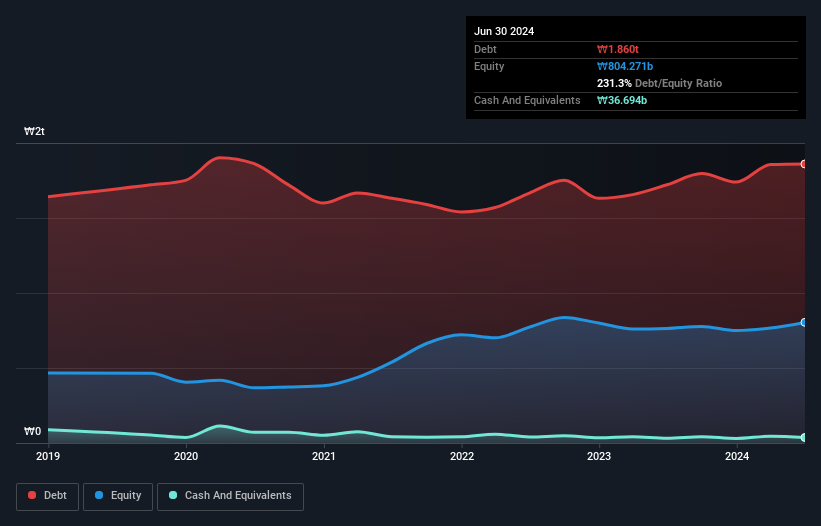Legendary fund manager Li Lu (who Charlie Munger backed) once said, 'The biggest investment risk is not the volatility of prices, but whether you will suffer a permanent loss of capital.' So it might be obvious that you need to consider debt, when you think about how risky any given stock is, because too much debt can sink a company. We note that Hyosung Advanced Materials Corporation (KRX:298050) does have debt on its balance sheet. But the more important question is: how much risk is that debt creating?
What Risk Does Debt Bring?
Debt is a tool to help businesses grow, but if a business is incapable of paying off its lenders, then it exists at their mercy. If things get really bad, the lenders can take control of the business. While that is not too common, we often do see indebted companies permanently diluting shareholders because lenders force them to raise capital at a distressed price. Of course, plenty of companies use debt to fund growth, without any negative consequences. When we examine debt levels, we first consider both cash and debt levels, together.
View our latest analysis for Hyosung Advanced Materials
What Is Hyosung Advanced Materials's Debt?
As you can see below, at the end of June 2024, Hyosung Advanced Materials had ₩1.86t of debt, up from ₩1.72t a year ago. Click the image for more detail. Net debt is about the same, since the it doesn't have much cash.

How Strong Is Hyosung Advanced Materials' Balance Sheet?
The latest balance sheet data shows that Hyosung Advanced Materials had liabilities of ₩1.95t due within a year, and liabilities of ₩520.5b falling due after that. On the other hand, it had cash of ₩36.7b and ₩626.8b worth of receivables due within a year. So its liabilities outweigh the sum of its cash and (near-term) receivables by ₩1.81t.
This deficit casts a shadow over the ₩1.20t company, like a colossus towering over mere mortals. So we definitely think shareholders need to watch this one closely. At the end of the day, Hyosung Advanced Materials would probably need a major re-capitalization if its creditors were to demand repayment.
We use two main ratios to inform us about debt levels relative to earnings. The first is net debt divided by earnings before interest, tax, depreciation, and amortization (EBITDA), while the second is how many times its earnings before interest and tax (EBIT) covers its interest expense (or its interest cover, for short). Thus we consider debt relative to earnings both with and without depreciation and amortization expenses.
While Hyosung Advanced Materials's debt to EBITDA ratio (4.9) suggests that it uses some debt, its interest cover is very weak, at 2.1, suggesting high leverage. So shareholders should probably be aware that interest expenses appear to have really impacted the business lately. Investors should also be troubled by the fact that Hyosung Advanced Materials saw its EBIT drop by 20% over the last twelve months. If that's the way things keep going handling the debt load will be like delivering hot coffees on a pogo stick. When analysing debt levels, the balance sheet is the obvious place to start. But ultimately the future profitability of the business will decide if Hyosung Advanced Materials can strengthen its balance sheet over time. So if you're focused on the future you can check out this free report showing analyst profit forecasts.
Finally, a company can only pay off debt with cold hard cash, not accounting profits. So the logical step is to look at the proportion of that EBIT that is matched by actual free cash flow. Looking at the most recent three years, Hyosung Advanced Materials recorded free cash flow of 26% of its EBIT, which is weaker than we'd expect. That's not great, when it comes to paying down debt.
Our View
To be frank both Hyosung Advanced Materials's level of total liabilities and its track record of (not) growing its EBIT make us rather uncomfortable with its debt levels. And furthermore, its net debt to EBITDA also fails to instill confidence. Taking into account all the aforementioned factors, it looks like Hyosung Advanced Materials has too much debt. That sort of riskiness is ok for some, but it certainly doesn't float our boat. There's no doubt that we learn most about debt from the balance sheet. But ultimately, every company can contain risks that exist outside of the balance sheet. For example, we've discovered 3 warning signs for Hyosung Advanced Materials (2 make us uncomfortable!) that you should be aware of before investing here.
When all is said and done, sometimes its easier to focus on companies that don't even need debt. Readers can access a list of growth stocks with zero net debt 100% free, right now.
Valuation is complex, but we're here to simplify it.
Discover if Hs Hyosung Advanced Materials might be undervalued or overvalued with our detailed analysis, featuring fair value estimates, potential risks, dividends, insider trades, and its financial condition.
Access Free AnalysisHave feedback on this article? Concerned about the content? Get in touch with us directly. Alternatively, email editorial-team (at) simplywallst.com.
This article by Simply Wall St is general in nature. We provide commentary based on historical data and analyst forecasts only using an unbiased methodology and our articles are not intended to be financial advice. It does not constitute a recommendation to buy or sell any stock, and does not take account of your objectives, or your financial situation. We aim to bring you long-term focused analysis driven by fundamental data. Note that our analysis may not factor in the latest price-sensitive company announcements or qualitative material. Simply Wall St has no position in any stocks mentioned.
About KOSE:A298050
Hs Hyosung Advanced Materials
Manufactures and sells industrial, polyester, nylon, and carpet yarns in South Korea and internationally.
Very undervalued with slight risk.
Market Insights
Community Narratives


